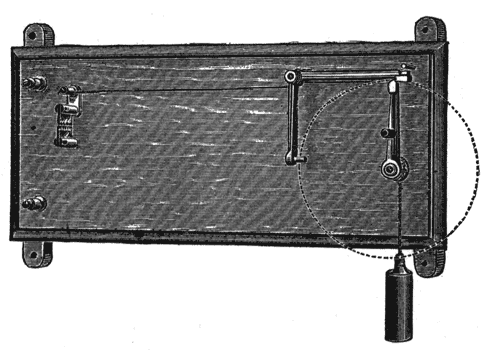[Trade Journal]
Publication: The Electrical Engineer
New York, NY, United States
vol. 10, no. 119, p. 158, col. 1-2
BAIN'S HOT WIRE LIGHTNING ARRESTER.
A LIGHTNING arrester, to be practical, should evidently protect the circuits when they are idle with as great fidelity as when the dynamos are in operation. It should ordinarily be so constructed as to have no self-induction, and an absolute break of sufficient distance to interpose enough resistance to open the arc should be made with every flash of lightning that comes in on the lines. These breaks should be absolute and not depend upon any equilibrium mechanism for the length of break; they should be automatic, so -as to take care of a number of flashes in rapid succession without any manual attention, and a further requirement is that they should protect circuits used for alternating currents with an equal degree of promptness and certainty as circuits which are used for straight currents.
 |
| Bain's Hot Wire Lightning Arrester. |
A device fulfilling all these conditions has been recently designed and patented by Mr. Foree Bain, of Chicago. The accompanying engraving shows how the circuit to ground is absolutely opened through the expansion of a small iron wire, due to the passage of the flash or the dynamo current. The iron wire forms a part of the circuit to ground, and as the lightning leaves the line at the comb it passes over this wire, which is expanded. A spring acting against the wire causes the trigger to unlatch the metallic winch, which forms part of the circuit, and to this winch is attached a string, wound round a drum, which is a part of the winch. To the string is hung a small weight, which causes the winch to revolve when released, so that when the wire has been expanded by the passage of current the winch makes three-quarters of a revolution and stops against an insulated stud on the arm, part of which forms the trigger. It then rests against this insulated stud, leaving the circuit to ground open until the wire contracts sufficiently to release it from the stud, when it completes the revolution and once more rests against the trigger and is ready for another flash to repeat the operation.
This arrester is said to be thoroughly reliable, and may be placed on either side of converters on alternating circuits, or in dynamo rooms on either alternating or continuous current circuits. In actual operation the wire does not get warm enough for the heat to be detected by touch.
The Central Electric Co., of Chicago, have taken the agency for Mr. Bain's arrester.
